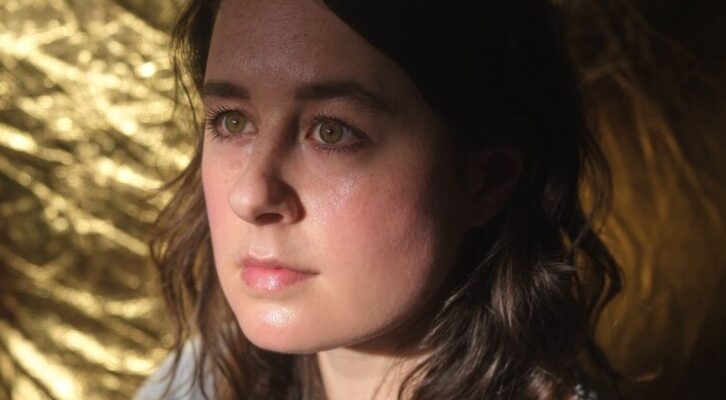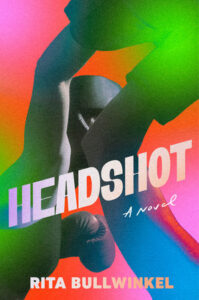
Rita Bullwinkel on Playing With Fictional Time
Jane Ciabattari Talks to the Author of “Headshot”
Rita Bullwinkel’s first novel, Headshot, is exhilarating to read. She experiments with form and bends time in uncanny ways. She sends us spiraling from the present, in a boxing gym in Reno, Nevada, where eight teenage girls are vying for a national championship on a hot summer day, into the past (one fighter recalls moments from her time as a lifeguard the day a young boy drowns while punching away; another contemplates her family’s fighting lineage: “If Artemis has a weakness It is in the fact that she is a legacy. Her sisters’ wins hang over her”), into the future (“As an actor, Tanya Maw will be given hundreds of roles to play. She will never be famous enough to not need other ways of getting money, but when she is old and frail she’ll become a beloved typecast granny”).
Throughout, Bullwinkel maintains a steady beat based on eight two-minute rounds per match, the referee’s calls, the sun’s path, and the bodily damage one fist can do (”And then there it is Artemis’s glove right between Andi Taylor’s eyeballs. Andi’s nose bleeding, Andi’s nose feeling like cornflakes”). Our email conversation about Headshot included follow-ups, all on Pacific coast time.
Jane Ciabattari: How have the last tumultuous years affected your life, your work, and the writing and launch of Headshot?
Rita Bullwinkel: Oof, I think it’s hard to tell? I am an extraordinarily slow processor, so I suspect I am still in the process of trying to understand the last years, and where we are now. I’ve always written in great spurts, and then go long periods of time where I don’t write, and that has also been true these last years.
JC: What drew you to set your first novel at the twelfth annual Women’s 18 and Under Daughter of America Cup at Bob’s Boxing Palace in Reno, NV, July 14-15, 20XX?
RB: Well, I made up the tournament and the name of the gym. I wanted to set the book in the year 20XX because I wanted the book to take place outside of time, in some sense. I set the book in Reno because I grew up vacationing there as a kid, and because it was then, and is still now, a very common place for youth athletic tournaments to take place.
JC: Did your own sports background, including time playing water polo in high school and college, inspire your work in Headshot? What sort of other research did you do? Attend boxing matches? Watch online?
I think sports and novel writing are both acts of extraordinary endurance that require some sense of abandon and willful delusion.
RB: The tournament of this book looks and feels like many youth athletic tournaments I participated in as a child. Most everything I know about boxing is from watching training videos online, unedited long documents that young women boxers take of themselves so that they can track the changing of their form over time. I also, as a youth athlete, took countless hours of footage of myself for the same purpose, although in my case the videos were of water polo, swimming, running and basketball. When I saw the training videos I knew I had some access to the youth women’s boxing world. The young women in those videos reminded me or myself.
JC: Part of the challenge of eighteen and under boxing (and wrestling) is the ability to endure a day-long set of matches without a break. How would you compare that with the experience of writing a novel?
RB: I think most sports tournaments operate like this. At swimming meets, for instance, you can compete in several races in the same day, sometimes within the span of an hour. I think sports and novel writing are both acts of extraordinary endurance that require some sense of abandon and willful delusion.
JC: How did you settle on your eight characters—the teens competing on this day, with under two dozen onlookers—and build their distinctive personalities?
RB: All eight of the main characters in this book are both me and not me. Each one has stolen bits of my biography, and also has nothing in common with me. I didn’t settle on them as much as meet them. They just appeared to me.
JC: Did you ever have a ratty raccoon-skin hat? Work as a lifeguard when a child drowned? Compete with siblings or cousins?
RB: I did have a ratty, David Crocket-style raccoon skin hat. I never worked as a lifeguard. My sister worked as a lifeguard. I worked for many years as a swim instructor to toddlers. When I was myself a toddler, my grandfather paid for expensive swim lessons for me and my sister because our cousin drowned in a pool before we were born. I never remember a time when I didn’t know how to swim, which is one of the reasons I was such an adept water polo player.
I’ve never competed against any of my cousins in sports. My sister and I never competed against each other in formal competitions, but we were always competing against one another in informal competitions. My sister is also an extremely strong swimmer (she also had the lessons) and was a semi-pro surfer when she was in high school.
JC: In each bout, you create a “two-hander,” as theater people call it, a back and forth between the two competitors, in distinctive, carefully crafted sections. Your deep interior point of view offers a vivid awareness of the competitors’ thoughts. How did you manage that?
RB: Oh gosh, thank you for this compliment, Jane! I love this theater term—I wasn’t aware of it. I did think of the boxing ring as a kind of theater, and I did think of each match as an exercise in portraiture. The deeper into the book I got, the easier it became to sling time around, and that’s why as the book progresses it goes deeper into both the past and farther into the future. I think I was able to manage this time-play, and the non-dialogue based conversation because the tournament map is so concrete and real.
JC: You also drop in exposition throughout, keeping us attuned to the facts of the situation, in a fluid alternation between interior and exterior. Was that pacing something that came naturally as you wrote, or did you create it during later drafts?
RB: That pacing was always the pacing of the book. There was very little revision.
JC: I’m curious about how you captured the ongoing experience of the competition. “As they sit on their stools, legs spread and red-faced, Artemis and Andi’s minds spin like wind turbines,” you write in the first bout. And later in the day, after many matches, “For Rachel Doricko, bouts don’t only stretch out time when she is fighting in them, they also stretch out time when she is watching them.”
RB: I do think that the playing of games has the unique and strange ability to form a collective memory, and that time always moves differently depending on the activity at hand.
JC: Your sense of time is fascinating. In each section, you carry us viscerally through punches and reactions, the atmosphere in the gym, and in Reno (including the heat of the day, the setting of the sun). You also jump backward and forward in time, giving us background and also sketching out a future for each fighter. Why this focus on flexibility in time? How do you manage it?
The best fiction makes me feel like I am being welcomed into an intimate relationship.
RB: Playing with time, or the bending of time, was something that came naturally with the book’s material. I think I have also, during periods in my life, experienced time this way, and I wanted to see if I could capture that feeling. Fiction is extremely adept at futzing with time. Bending time is perhaps the medium’s greatest weapon. Nothing can bend time, make it stop, or make it expand, like literary fiction. While writing this novel, my first novel, I was like a kid that had just been given a beautiful, rare knife. I wanted to use the knife.
JC: You’ve recently become the editor of McSweeney’s Quarterly, after being an editor at large, and also deputy editor of The Believer and a contributing editor for Noon. How does being an editor help or hinder your writing of fiction?
RB: I started writing because what I was reading was changing me so greatly. Everyone that works at McSweeney’s is also a writer, or a working artist, in their own right. I think it makes sense that someone obsessed with writing and reading fiction would also edit a literary quarterly. I’m not sure if being in an editor helps or hinders my writing. I think it’s just two parts of the same work.
JC: How do your teaching and translation mesh with your editing and fiction writing ? In particular, teaching about the uses of invented and foreign languages in world building? What’s that like?
RB: I think that all writing is an exercise in world building. Even so-called “realist” fiction often alters and invents language. I teach courses on the uses of invented and foreign languages as tools for world building because those are tools that interest me, that I enjoy reading, and that I aspire to use in my own writing. These classes are very fun classes to teach. Students instinctively know that one of the ways a story is made powerful is if the language of a story belongs to the story.
People who are close to one another—lovers, friends, family members—often use invented language when they are speaking with one another. Invented language is a private language. It’s intimate. The best fiction makes me feel like I am being welcomed into an intimate relationship. Invented language is one way writers can do that.
JC: What are you working on now/next?
RB: I’m working on another novel.
JC: Can you give a sense of what inspired the novel-in-progress? What’s it about? The stage it’s at? The setting, characters? Anything you care to share?
RB: I won’t say! Soon, maybe, I’ll be able to talk about—but not yet. Something horrible happens when you talk about a project before the project is ready to be talked about. It dies a little.
__________________________________

Headshot by Rita Bullwinkel is available from Viking Books, an imprint of Penguin Publishing Group, a division of Penguin Random House, LLC.
Jane Ciabattari
Jane Ciabattari, author of the short story collection Stealing the Fire, is a former National Book Critics Circle president (and current NBCC vice president/events), and a member of the Writers Grotto. Her reviews, interviews and cultural criticism have appeared in NPR, BBC Culture, the New York Times Book Review, the Guardian, Bookforum, Paris Review, the Washington Post, Boston Globe, and the Los Angeles Times, among other publications.



















